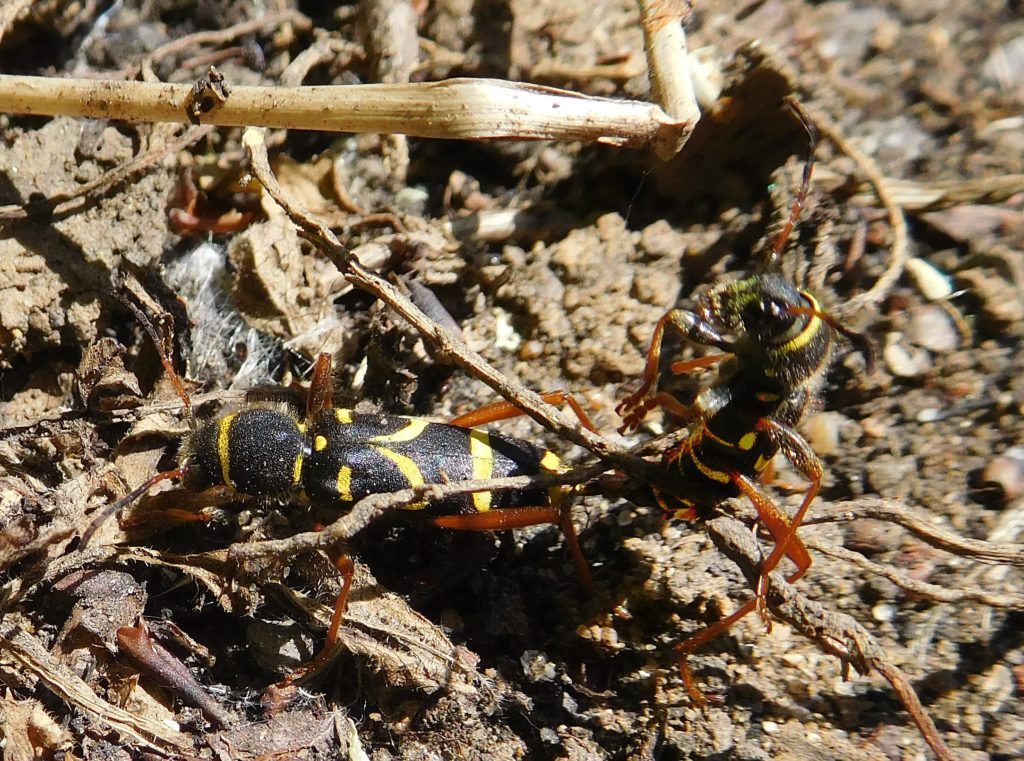
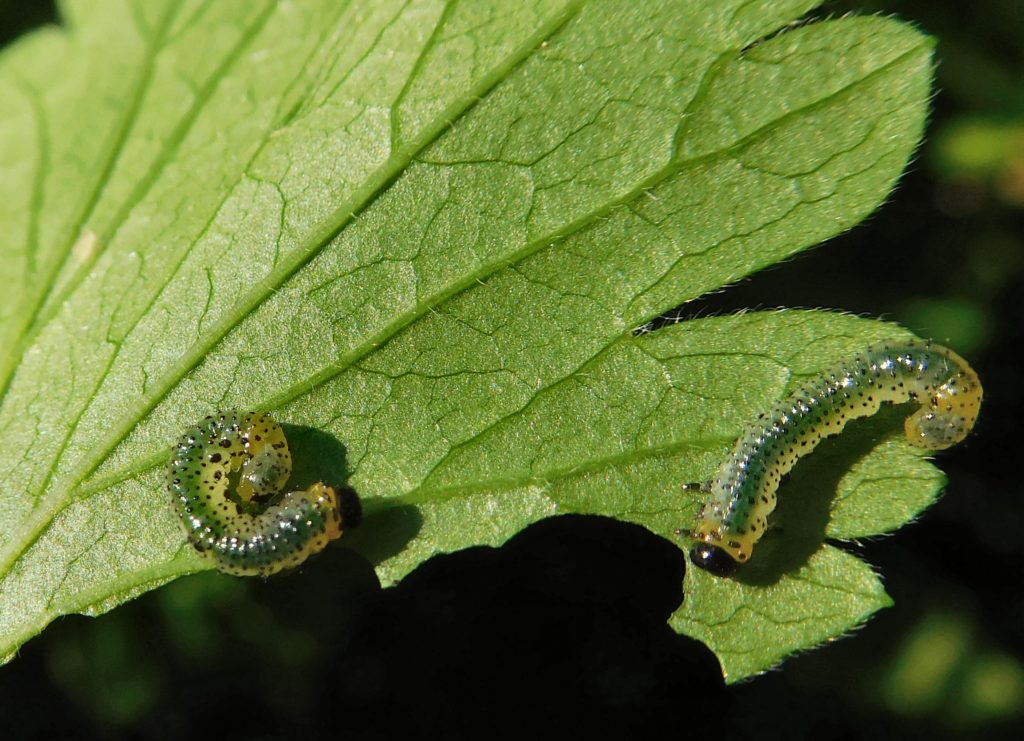

A miniature drama unfurled in my garden this morning, little streaks of orange and black sparkling in the sun as they chose places to land and sun themselves. They seemed to be newly-emerged, as they immediately stretched out their wings on landing: and if you look closely, you can see that the wings are not fully deployed, but are still soft and need to be puffed out quickly before they harden. If so, it’s remarkable that these little flies can take to the air in that condition.

La Belle Noiseuse, the beautiful nuisance, roughly. Not the female sculptor in Jacques Rivette‘s 1991 film, starring Emmanuelle Béart, but a small sawfly. It’s a glorious little insect, shining in the sunlight, its deep orange-ochre abdomen contrasting with its black thorax and head, its legs elegantly banded black on orange, giving it a slightly waspish look in flight. (Indeed, it is presumably a Batesian mimic of wasps, benefiting by looking as if it might sting.)
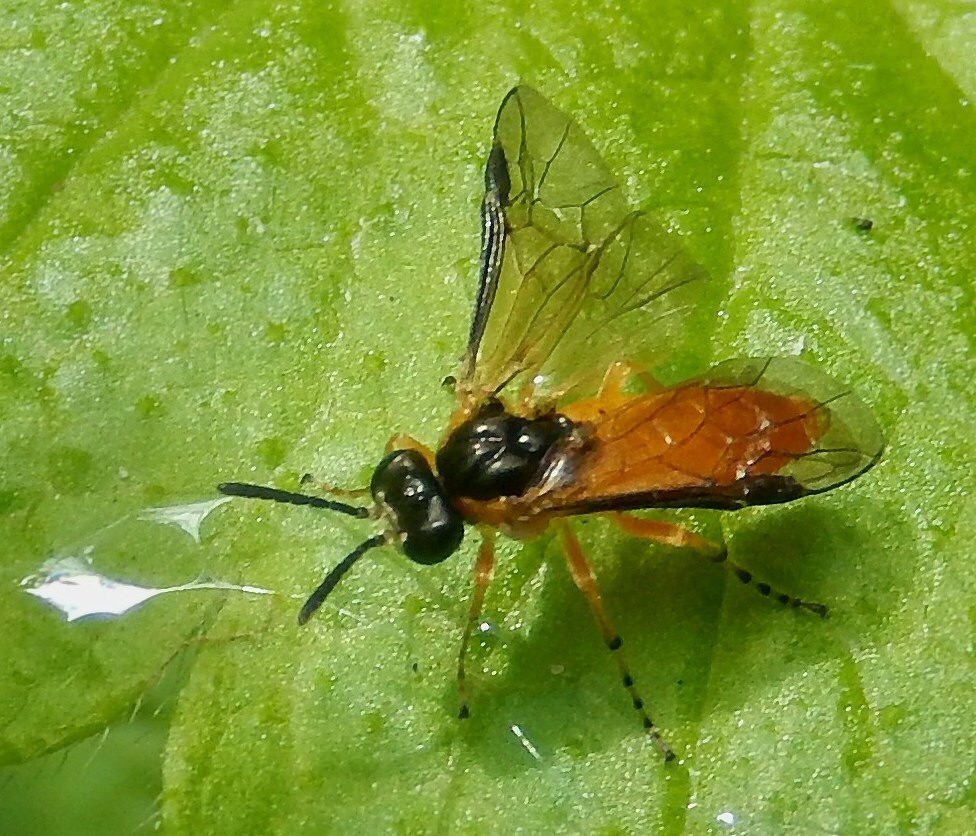
But its nuisance value does not lie in stinging, but in its caterpillar-like larvae, which devour the leaves of gooseberries and can defoliate whole bushes.
Still, it’s a splendid sight.
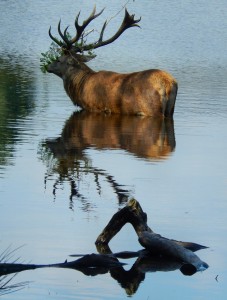
An Indian Summer is one of those special times. Yes, autumn is here; yes, flowers and leaves will soon fall; yes, season of mists and mellow fruitfulness, all of that: but for a brief moment, we know it is warm, even hot; that the time is precious, and we must seize the moment; and we drop everything to go outside with binoculars and camera to see whatever is to be seen.
And it is as wonderful as we could have hoped, warm and blithe. The Jackdaws hop about, quick to take their opportunities: some seem to live exclusively on sandwiches and crumbs. A Jay perches close by on an oak branch, abandoning the usual caution of its species. A series of high-pitched calls is not the usual posse of Ring-Necked Parakeets, but a family group of three Hobbies almost overhead, wheeling, diving, chasing each other, showing off their power and agility with long angled wings, stooping into a mock dive, fanning a tail, their black moustaches clearly visible.
Down at the Pen Ponds, pairs of Common Darter dragonflies are still in cop, laying eggs while the sun shines; around them zip Migrant Hawkers, and I glimpse one blue damselfly too. We walk around the ponds; a Heron flaps quietly across the water; a pair of Mute Swans ride high towards us, their two grey cygnets sailing between them.
And then, quite suddenly, I saw him: a stag with fine 14-point antlers, brimming with testosterone, preparing for the autumn rut. He stood quite still, up to his belly in the water. He had decorated his head with vegetation – Bracken and some Oak twigs – and was now quietly absorbing the elements, sun and water, as he listened to the occasional preliminary roar of another stag in the distance. In a few weeks he will be fighting for a harem of hinds; but today, he seemed contemplative.
A few hundred yards away, in the open grassland, a group of twenty hinds is accompanied by a couple of young males with nearly straight antlers. A big stag will surely put them to flight in an instant when the rut begins; but today, they grazed quietly with the females.
A Buzzard soared overhead, circling in the fair-weather thermals; one of the young Hobbies dashed past.
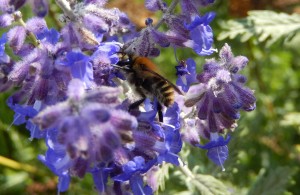

In the beautiful garden of Pembroke Lodge, they were preparing for a wedding, the lawn looking its verdant best, the bees buzzing softly in the still colourful flowerbeds full of tall daisies and delphiniums, lavender and alkanet. On the belvedere terrace, with its spacious view to the West, lovers made soft conversation at the café tables.
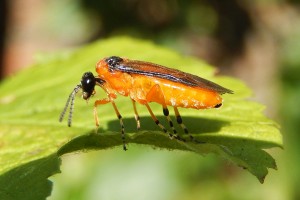
Back at home, a pair of bright saffron-coloured Gooseberry Sawflies (there are actually several species that attack gooseberries and other currants indifferently, I’m not sure what species this one is) were joyfully mating near my currant bushes, while others flew sedately about – they have a rather unusual steady flight, not like anything else. The air was warm and light; and the sawflies did not seem to have made any impact on the fruit crop. I was happy to get a photograph of one of the tiny insects, happy to see them flourishing in this Indian Summer.
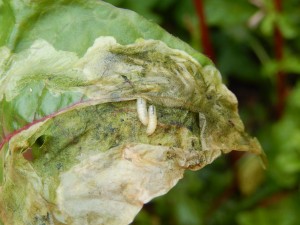
Well, I usually try to take a pretty picture to start off a posting, but this one certainly doesn’t qualify. These leaf miners grow entirely inside a leaf, in this case of Spinach Beet. As you can see, as they grow they tunnel around below the leaf’s upper epidermis, which is a translucent layer of cells, leaving it intact to provide themselves with a ready-made cover.
Underneath that sheet, a healthy leaf contains a thick green set of palisade cells in one or several layers. These are the leaf’s (and the plant’s) factory, as they are full of chloroplasts, coloured green to absorb light: they synthesize the sugars on which life depends.
Not many people would want to eat this leaf, once the leaf miner larvae – mostly moths – have been at work. The palisade layers are entirely and efficiently destroyed wherever the insects have been. All that remains is an air-space and some dark frass: all, that is, but for the plump whitish cylindrical bodies of the larvae themselves.
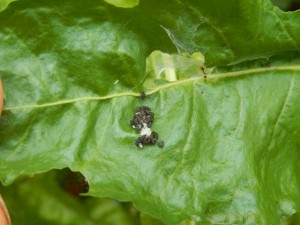
Also nesting on the spinach are some ladybirds. These have incomplete metamorphosis, the young being able to walk as well as eat from their first stage or instar. Each time they moult they change in appearance as well as in size. They mainly eat aphids, troublesome pests of many crops, so they are useful to gardeners and to any farmers who don’t want to use insecticides.
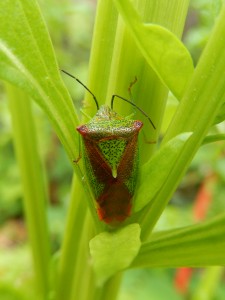
This shield bug, seen here in close-up, may look conspicuous enough, but that is the camera’s view. The insect is actually rather well camouflaged, and it generally hides under a leaf where it is in some shadow. The camouflage consists first of a general colour resemblance to its background, with its overall grass-green coloration; and as seen here, it is also disruptively patterned, with the reddish brown of its wings tending to break up its outline. Perhaps it is also somewhat countershaded, with dots stippling its back. Bugs suck plant juices, and their larvae can be quite destructive, but they never seem to do much harm to the spinach.
There are also some green caterpillars, excellently camouflaged with a pale cream stripe all along their sides. (It might be the Hebrew Character moth.) You might expect this to be conspicuous, but it seems to be a classic piece of disruptive coloration: the stripe appears like a sun-glint specular highlight on the shiny crumpled surface of the spinach leaf, rather than part of a solid, round-bodied animal.
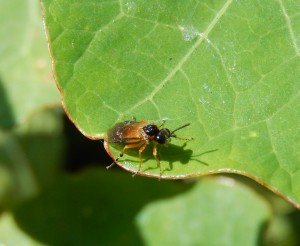
A pest I know is there is the Gooseberry Sawfly. There are numerous sawflies in the garden right now, but they are all flying around the Nasturtiums, nowhere near the gooseberry bush. However… plenty of the lower leaves of the gooseberry are badly damaged by sawfly larvae, some eaten right down to the petiole, pathetic little stumps with a few short branching veins all that remains of once green foliage. What to do about it? This isn’t a how-to-garden site, but inspect your gooseberry bush(es) regularly, looking especially at the lower leaves to see if they’re being eaten. If some are, check the edges for caterpillars. If you find any, spray the bush after sunset on a dry still evening (to avoid killing the bees that are pollinating your fruit) with a garden insecticide.
Five minutes of careful searching of half-eaten gooseberry leaves failed to reveal a single larva. The cause in this case is not so much camouflage as the incredibly intense predation by Blue Tits (and Great Tits). I estimate these little birds are a hundred times better at finding caterpillars than I am. They have the advantage of getting in close – they must be able to focus down to a few centimetres, their small eyes acting as short-focus wide-angle lenses – and of being able to perch anywhere in a bush. They also get up very early, and know instinctively exactly what food looks like: small well-camouflaged caterpillars on the undersides and edges of leaves.
Zoologists suppose that birds have a ‘search image’ of the prey they are hunting: perhaps this is much the same idea as the training images that computer scientists use to teach their neural nets to recognise patterns such as faces. Once you have such an image in your brain, you almost instantly recognise your target when it appears. To give a small illustration, I remember when I had a small motorbike, I always saw bike shops everywhere; now I never notice them. My eye was attuned, like a Blue Tit’s to a caterpillar.